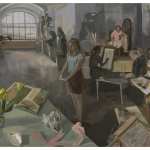I recently received an email from Helen Chellin, aritst and founder of the amazing Red Cinder Creativity Center and Artists’ Residency on the Big Island of Hawaii, where I spent time writing in 2004. After thirteen years, Helen has decided to discontinue the residency to focus on other projects. In contrast to more established residencies like, say, Yadoo or MacDowell, Helen didn’t have an endowment or an enormous estate, but she opened her home to artists from all over the world, charging $23 for food and $23 for lodging each day. A complete DIY effort, she cleverly enlisted her nearby neighbor to do the cooking and counted on residents to do the dishes and provide community. My visit to Red Cinder was extraordinary–I suspect it’s the only residency near a live, steaming, burbling volcano. To help other artists who might be interested in starting a residency program, Helen agreed to answer a few questions about her experience.
Two Coats of Paint: Why did you decide to start a residency program?
Helen Chellin: Drawing from my own experience of being an artist in residence, believing that all artists need such times away from their regular routines to stimulate and focus creativity. The problem, I found, was that as a full-time parent with a business to run, I could not take advantage of most traditional artist-colony programs, which require at least a month�s residency. I realized that there must be many serious artists in similar situations, and I began to think about creating a place where artists with �other lives� could come for shorter time periods, yet be in a true retreat setting with a community of fellow artists. I found the perfect location for this program on 10 acres in rural Big Island Hawaii.
TCOP: What kinds of changes/improvements did you have to make to the house?
HC: The painting/sculpture studios were constructed from the stable building. We punched skylights into the roof, put in a concrete floor over the hay and dirt and made painting walls. After each residency we repaint walls so each artist has a �clean slate�. We added sliding glass and screened doors over the stall openings. Lastly we put in water and power. The barn studios are a workspace only. These artists have sleeping rooms in the main house. The indoor garage at the main house was transformed into a dance studio with new floor and mirrors. It is a live/work space. The main house has two live work spaces for writers, one live/work for mixed media artists and the dance studio is live work with sleeping alcove. We added two bathrooms for a total of three.
TCOP: How did you handle food, cleaning and all the other household details?
HC: We had a food contractor who brought in supplies for breakfast, lunch and snacks that the artists made and cleaned up. The chef cooked dinners. Each artist took 3 rotations at cleanup after dinner. The residents were responsible for their own rooms and laundry. Red Cinder staff cleaned the common areas.
TCOP: How did the program evolve over time?
HC: Like life, Red Cinder was a huge learning curve. The mission of offering the gift of time did not change much. The residencies were two weeks long. Pre residency information expanded as I got to know what individuals needed before start date as to materials, personal items, life in a very rural, dial-up only internet connection world. I did have a questionnaire that artists could offer insight into how to make workspaces better and issues around noise and privacy. The food was always great and Red Cinder was not responsible for weight gain. Each residency was unique and I respected those dynamics and went with them.
TCOP: Was it difficult deciding to end the program? What were the factors involved?
HC: It was very difficult. It is has been 15 years since I came to Red Cinder Creativity Center and 13 since I began the process of building the residency program. Like the island itself it has been a process filled with creation, invention, spirit and community. It has been a time full of surprises and growth under the watchful eyes of Madame Pele whom I honor and thank for her part in its existence.
Last summer I turned 65 and felt a shift of focus and energy. I decided to close the program for a year to sort out my feelings and plans.
It is time to change directions.
It will take time to realize all the gifts gained by all who came through Red Cinder�s doors. I value so much all the sharing and the opportunity to have time and focus for working on one�s art and craft. The coming together in community while learning respect for personal boundaries and space was also a part of an artist�s time at Red Cinder.
TCOP: Do you have any advice for someone who might be thinking of starting a residency program?
HC: The best thing is to contact the Alliance of Artist Communities. They have a complete guides on how to get started and then how to keep going.
TCOP: What are your plans?
HC: I will be redesigning the Red Cinder website and the old one will be shut down. I will continue to develop ideas and events with and for artists. The form of these is in development. I will continue as well to see creativity as a tool for change, growth and intelligence. I will continue to work with others to care for our planet. I plan to do this work in San Francisco, Hawaii and Australia.
——-
Subscribe to Two Coats of Paint by email.



















Interesting idea. I'd love to start a residency at my country house. Thanks for posting.
thanks for posting this.
Just curious (as an artist looking) if you ever started one as well?